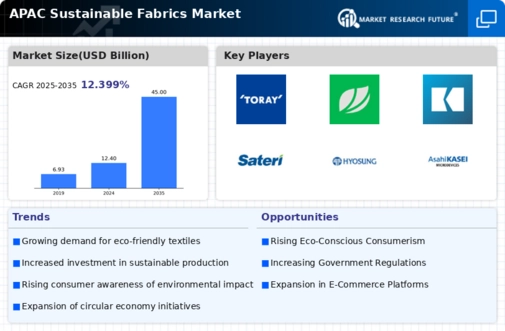The APAC Sustainable Fabrics Market is a rapidly evolving sector characterized by a growing emphasis on eco-friendly materials and practices. With increasing awareness of environmental sustainability, manufacturers and retailers are facing pressure to adopt green initiatives and reduce their carbon footprints. In recent years, the demand for sustainable fabrics has surged as consumers seek products that align with their values. This shift is evident across various segments, including apparel, home textiles, and industrial applications.
The market is highly competitive, featuring a mix of established players and newer entrants that are focusing on innovations in bio-based materials, recycled fibers, and sustainable production processes. The competitive landscape is shaped by factors such as technological advancements, supply chain dynamics, regulatory changes, and consumer preferences, creating both challenges and opportunities for companies operating in this sector.Toray Industries stands out in the APAC Sustainable Fabrics Market due to its strong commitment to sustainability and innovation.
As a major player, Toray has invested heavily in research and development, enabling it to produce a variety of high-performance fabrics that are both environmentally friendly and commercially viable. The company’s portfolio includes advanced materials that are utilized in sportswear, functional textiles, and other apparel applications. The noteworthy strength of Toray Industries lies in its extensive experience and expertise in polymer chemistry, which significantly contributes to its ability to develop innovative solutions in sustainable fabrics.
Additionally, the company has established robust supply chain networks and partnerships across the APAC region that enhance its market reach, allowing it to respond effectively to changing consumer demands in a timely manner.China National Chemical Corporation, known for its vast and diversified portfolio in chemical production, plays a significant role in the APAC Sustainable Fabrics Market. The company has strategically focused on expanding its sustainable textile solutions, offering a range of products, including high-tech fibers and chemical agents used in textile manufacturing.
With a strong market presence across APAC countries, China National Chemical Corporation leverages its extensive production capabilities and technological expertise to create fabrics that meet sustainability standards. The company’s strengths lie in its ability to create partnerships and collaborations within the textile sector, facilitating the development of innovative products that cater to both domestic and international markets. Recent mergers and acquisitions have further solidified their position, allowing for enhanced research capabilities and a broader product offering in sustainable fabric solutions targeted at environmentally conscious consumers across the region.






















Leave a Comment